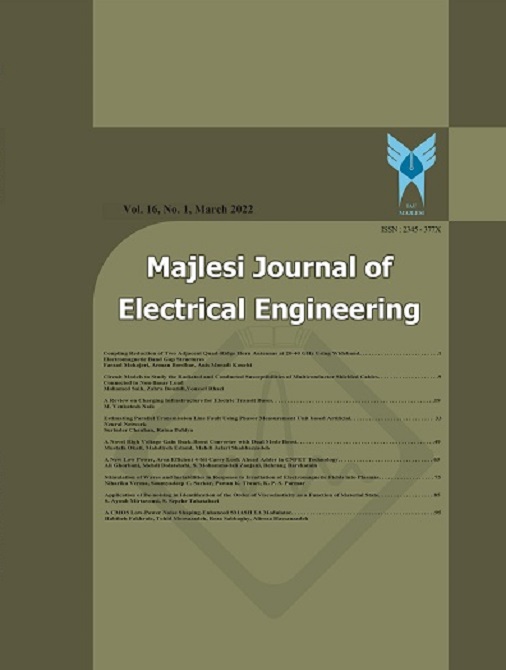[1] Hingorani N. G. And Gyugyi L., Understanding FACTS Concept and Technology of Flexible AC Transmission System: Wiley IEEE Press, 2000.
[2] X. Zhou, H. Wang, R. K. Aggarwal, and P. Beaumont, “Performance evaluation of a distance relay as applied to a transmission system with UPFC,” IEEE Trans. Power Deliv., vol. 21, no. 3, pp. 1137–1147, 2006.
[3] F. A. Albasri, T. S. Sidhu, and R. K. Varma, “Performance comparison of distance protection schemes for shunt-FACTS compensated transmission lines,” IEEE Trans. Power Deliv., vol. 22, no. 4, pp. 2116–2125, 2007.
[4] M. Khederzadeh and A. Ghorbani, “Impact of VSC-based multiline FACTS controllers on distance protection of transmission lines,” IEEE Trans. Power Deliv., vol. 27, no. 1, pp. 32–39, 2012.
[5] Z. Moravej, M. Pazoki, and M. Khederzadeh, “Impact of UPFC on power swing characteristic and distance relay behavior,” IEEE Trans. Power Deliv., vol. 29, no. 1, pp. 261–268, 2014.
[6] Kumar B., Yadav A.,"Backup protection scheme for transmission line compensated with UPFC during high impedance faults and dynamic situations," IET Sci. Meas. Technol; vol. 11, no. 6, pp. 703–712, 2017.
[7] M. C. R. Paz, R. C. Leborgne, and A. S. Bretas, “Adaptive ground distance protection for UPFC compensated transmission lines: A formulation considering the fault resistance effect,” Int. J. Electr. Power Energy Syst., vol. 73, pp. 124–131, 2015.
[8] H. Mehrjerdi and A. Ghorbani, “Adaptive algorithm for transmission line protection in the presence of UPFC,” Int. J. Electr. Power Energy Syst., vol. 91, pp. 10–19, 2017.
[9] C. D. Schauder et al., “Operation of the Unified Power Flow Controller (UPFC) under practical constraints,” IEEE Trans. Power Deliv., vol. 13, no. 2, pp. 630–637, 1998.
[10] P. K. Dash, A. K. Pradhan, and G. Panda, “Distance protection in the presence of unified power flow controller,” Electr. Power Syst. Res., vol. 54, no. 3, pp. 189–198, 2000.
[11] S. R. Samantaray, “Decision tree-based fault zone identification and fault classification in flexible AC transmissions-based transmission line,” IET Gener. Transm. Distrib., vol. 3, no. 5, p. 425, 2009.
[12] S. R. Samantaray, “A data-mining model for protection of facts-based transmission line,” IEEE Trans. Power Deliv., vol. 28, no. 2, pp. 612–618, 2013.
[13] A. Manori, M. Tripathy, and H. O. Gupta, “SVM based zonal setting of Mho relay for shunt compensated transmission line,” Int. J. Electr. Power Energy Syst., vol. 78, pp. 422–428, 2016.
[14] L. Tripathy, M. K. Jena, and S. R. Samantaray, “Decision tree-induced fuzzy rule-based differential relaying for transmission line including unified power flow controller and wind-farms,” IET Gener. Transm. Distrib., vol. 8, no. 12, pp. 2144–2152, 2014.
[15] R. Dubey, S. R. Samantaray, B. K. Panigrahi, and Vijendran G. Venkoparao, “Extreme Learning Machine Based Adaptive Distance Relaying Scheme for Static Synchronous Series Compensator Based Transmission Lines,” Electr. Power comp.and syst. vol. 44, no. 2, pp. 219-232 December, 2015.
[16] Z. Moravej, S. Member, M. Pazoki, M. Khederzadeh, and S. Member, “New Pattern-Recognition Method for Fault Analysis in Transmission Line With UPFC,” vol. 30, no. 3, pp. 1231–1242, 2015.
[17] A. Yadav and A. Swetapadma, “Electrical Power and Energy Systems A single ended directional fault section identifier and fault locator for double circuit transmission lines using combined wavelet and ANN approach,” vol. 69, pp. 27–33, 2015.
[18] A. Yadav and A. Swetapadma, “Improved first zone reach setting of artificial neural network-based directional relay for protection of double circuit transmission lines,” IET Gener. Transm. Distrib., vol. 8, no. 3 pp. 373–388, 2014.
[19] SimPower Systems Toolbox ver. 8.1, for use with Simulink, User’s Guide. The Math Works, Inc., 2013a.

